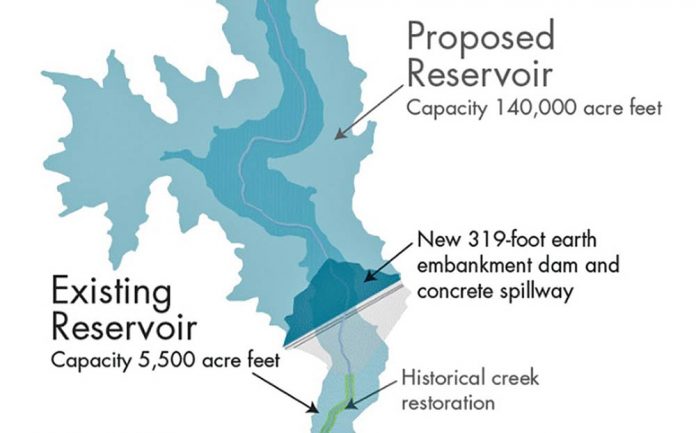California is on track to build a $1 billion dam and create a giant reservoir at Pacheco Pass that will dwarf the existing reservoir and dam near Highway 152 east of Gilroy, with construction beginning in 2024.
New evidence from an independent nationwide study of dam safety suggests a new incentive for the project—safety—in addition to the stated goals of securing long-term drinking water resources and improving fish habitats.
A more than two-year investigation by the Associated Press has found that scores of dams nationwide are in bad shape, and many are in dangerous locations—with Pacheco Pass on the ‘high hazard” list. In many sites across the US, these potential disasters “loom over homes, businesses or entire communities that could face life-threatening floods if the dams don’t hold,” the AP reported.
A review of federal data and reports obtained by the news service under state open records laws identified 1,688 high-hazard dams rated in poor or unsatisfactory condition as of last year in 44 states and Puerto Rico. “The actual number is almost certainly higher,” the report stated, because some states declined to provide condition ratings for their dams, claiming exemptions to public record requests. “Others simply haven’t rated all their dams due to lack of funding, staffing or authority to do so.”
Luckily for this region, the North Fork of Pacheco Creek flows south, away from populated areas, meandering through ranches and sparsely populated range land until it reaches the Pajaro River well southeast of Hollister. Casa de Fruta is about six miles southwest of the current dam, and Hollister is another 10 miles away. A dam failure emptying Pacheco Lake, while catastrophic, likely would threaten few homes or lives.
Deaths from dam failures have declined since a series of catastrophic collapses in the 1970s prompted the federal and state governments to step up their safety efforts, the AP study said, citing Stanford University’s National Performance of Dams Program.
The nation’s dams are over a half-century old on average. The Pacheco Dam is even older: It was built in 1939.
“There are thousands of people in this country that are living downstream from dams that are probably considered deficient given current safety standards,” Mark Ogden told AP. Ogden is a former Ohio dam safety official who is now a technical specialist with the Association of State Dam Safety Officials, which estimates it would take more than $70 billion to repair and modernize the nation’s more than 90,000 dams.
“Most people have no clue about the vulnerabilities when they live downstream from these private dams,” former federal emergency administrator Craig Fugate is quoted as saying. “When they fail, they don’t fail with warning. They just fail, and suddenly you can find yourself in a situation where you have a wall of water and debris racing toward your house with very little time, if any, to get out.”
The North Fork Dam, as the current Pacheco Pass dam is called, has for years been considered a “high-hazard dam in poor condition,” and was last inspected by the state in 2017.
The dam is 100 feet high and 600 feet long and contains 325,000 cubic yards of material. The reservoir dam is an impassable barrier to in-migrating steelhead trout, while resident rainbow trout (the landlocked form of steelhead) thrive in fast-water habitats above the dam.
Construction of a new Pacheco Reservoir received an important thumbs-up in a new environmental impact statement released in August.
The project would build a new dam and expanded reservoir on the North Fork of Pacheco Creek that could hold 140,000 acre-feet of water, a substantial increase from the 5,500-acre-foot capacity of the existing reservoir built 80 years ago.
The reservoir is located about 13 miles southwest of San Luis Reservoir off Highway 152.
The California Water Commission last year awarded the Pacheco Reservoir Expansion Project $484.55 million under Proposition 1, the water bond approved by voters in 2014 to fund new dams and water storage projects in California. This grant represents the full amount that was requested by a partnership of the San Benito County Water District, Santa Clara Valley Water District and Pacheco Pass Water District.
Construction of the $1 billion Pacheco Reservoir near Casa de Fruta would start in 2024, with a completion date of 2029, if federal and local funds are obtained.
The new draft environmental report favors construction of a new reservoir. A final environmental report is expected in the summer of 2020.








